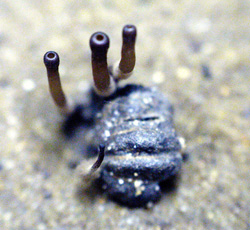Remember to scout for mummy berry in blueberries
Editor’s note: This article is from the archives of the MSU Crop Advisory Team Alerts. Check the label of any pesticide referenced to ensure your use is included.
This is the time of year to start looking for overwintered mummy berry mummies on the ground underneath blueberry bushes. It may require some crawling around on your hands and knees to get close to the target. Mummy berry mummies look like tiny black pumpkins (about 3/8 inch in diameter) and may be partially embedded in the soil or located underneath leaf litter. Germinated mummies have small, brown, finger-like projections (stipes) that eventually develop into apothecia which look like small brown trumpets. There can be anywhere from one to seven stipes on a mummy. Depending on how wet the site is, only 10-20 percent of mummies actually germinate in any one year. It is therefore advisable to scout in “hot spots” first, especially wet areas and in rows close to the woods.

Germinated mummy with four
immature apothecia.
Photo credit: Phillip Wharton.
The number of apothecia is the best predictor of the number of shoot strikes. Even if there are lots of mummies, but none has germinated, the risk of infection will be low. Apothecia start shooting ascospores into the air when the cups are about 1/8 inch in diameter. The spores are released when the mushrooms are disturbed or the air pressure changes, and are dispersed by wind. If any green leaf tissue is visible at that time, there is a risk of infection. Most spores are released when the cups are between ¼ and ½ inch wide. During cool wet conditions, the apothecia can release small amounts of spores for up to two to three weeks. Under warm dry conditions, they may last only 1 week. However, they are likely to release lots of spores during that week, as many as 1 million spores per day. Prolonged cool, wet weather is conducive to infection. At the optimum temperature (57ºF), only 6 hours of leaf wetness are required for infection. Frost (28-30ºF) can also predispose shoots to infection.



 Print
Print Email
Email



